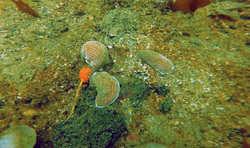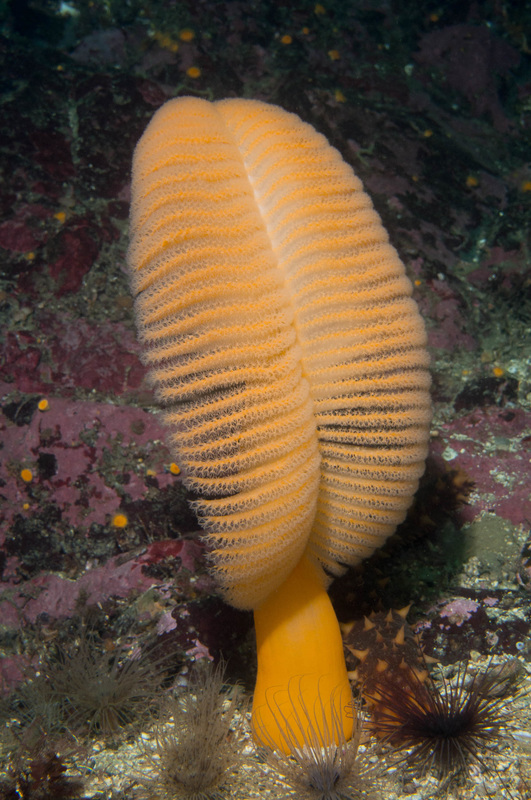Orange sea pen, sea feather, fleshy sea pen, Gurney's sea pen • Ptilosarcus gurneyi
|
Identification
The orange sea pen, which can be up to half a metre tall, looks like a large fluffy ostrich plume ranging in colour from dark orange to yellow or white. Instead of a single animal, it is a colony of polyps arranged into thick fleshy branches; these branches attach to the stalk, which is the primary polyp that has been modified. This polyp has lost its tentacles, and provides structure and support with an internal calcareous rod (its "skeleton") and a thickened bulb-like base, most of which is buried in the sediment. The orange sea pen has an amazing ability to contract and expand by expelling or taking on water; the feather-like structure may become unrecognizable when the colony contracts down below the sediment, as it can bury nearly its entire length if sufficiently threatened. This cnidarian is grouped with the sea anemones and corals into Class Anthozoa. Habitat & Range The orange sea pen anchors its bulbous base into sandy or muddy sea floors from the shallow subtidal to 135 m deep. It is not attached to anything, however; it is able to This species can form beds, which may be as dense as 20 pens per square metre. Its range extends from the Gulf of Alaska to southern California. |

Photo by Jenn Burt
Intriguing Info
When threatened the colony is able to retract the hard inner rod that gives it structure, as well as its feathery fleshy parts. Instead of burrowing deeper into the sediment, it contracts its body down into the below-surface area already occupied by its base, as a third of its length is buried when the pen is fully expanded. How much it contracts varies depending on which predator is posing a threat: one study found that the leather star (Dermasterias imbricata), which specializes on orange sea pens, causes a larger contraction than the sunflower star (Pycnopodia helianthoides), which does not specifically target sea pens but rather preys on a multitude of species. The orange sea pen is also preyed upon by some other sea stars as well as multiple nudibranch species, such as the opalescent nudibranch (Hermisseda crassicornis) and the striped nudibranch (Armina californica), seen attacking a sea pen in the image at right. Orange sea pens do not only burrow in response to predators; they appear to regularly deflate when not feeding. Click here to learn more about orange sea pen 'burrowing'; click here to learn more about this species' predators.
If disturbed this species may glow greenish-blue.
iNaturalist
https://www.inaturalist.org/taxa/448320-Ptilosarcus-gurneyi
When threatened the colony is able to retract the hard inner rod that gives it structure, as well as its feathery fleshy parts. Instead of burrowing deeper into the sediment, it contracts its body down into the below-surface area already occupied by its base, as a third of its length is buried when the pen is fully expanded. How much it contracts varies depending on which predator is posing a threat: one study found that the leather star (Dermasterias imbricata), which specializes on orange sea pens, causes a larger contraction than the sunflower star (Pycnopodia helianthoides), which does not specifically target sea pens but rather preys on a multitude of species. The orange sea pen is also preyed upon by some other sea stars as well as multiple nudibranch species, such as the opalescent nudibranch (Hermisseda crassicornis) and the striped nudibranch (Armina californica), seen attacking a sea pen in the image at right. Orange sea pens do not only burrow in response to predators; they appear to regularly deflate when not feeding. Click here to learn more about orange sea pen 'burrowing'; click here to learn more about this species' predators.
If disturbed this species may glow greenish-blue.
iNaturalist
https://www.inaturalist.org/taxa/448320-Ptilosarcus-gurneyi
|
|
|
References
Carefoot, T. Sea Pen: Burrowing. In A Snail's Odyssey. Accessed 10/03/2015.
Carefoot, T. Sea Pen: Predators & Defenses. In A Snail's Odyssey. Accessed 10/03/2015.
Cowles, D. (2005). Ptilosarcus gurneyi (Gray, 1860). Invertebrates of the Salish Sea. Rosario Beach Marine Laboratory. Accessed 10/03/2016.
Lamb, A., and Hanby, B. (2005). Marine Life of the Pacific Northwest [electronic version]. Madeira Park, BC: Harbour Publishing.
Sea pen. Monterey Bay Aquarium. Accessed 10/03/2016.
Authors and editors of page
Kelly Fretwell (2016).
Carefoot, T. Sea Pen: Burrowing. In A Snail's Odyssey. Accessed 10/03/2015.
Carefoot, T. Sea Pen: Predators & Defenses. In A Snail's Odyssey. Accessed 10/03/2015.
Cowles, D. (2005). Ptilosarcus gurneyi (Gray, 1860). Invertebrates of the Salish Sea. Rosario Beach Marine Laboratory. Accessed 10/03/2016.
Lamb, A., and Hanby, B. (2005). Marine Life of the Pacific Northwest [electronic version]. Madeira Park, BC: Harbour Publishing.
Sea pen. Monterey Bay Aquarium. Accessed 10/03/2016.
Authors and editors of page
Kelly Fretwell (2016).





